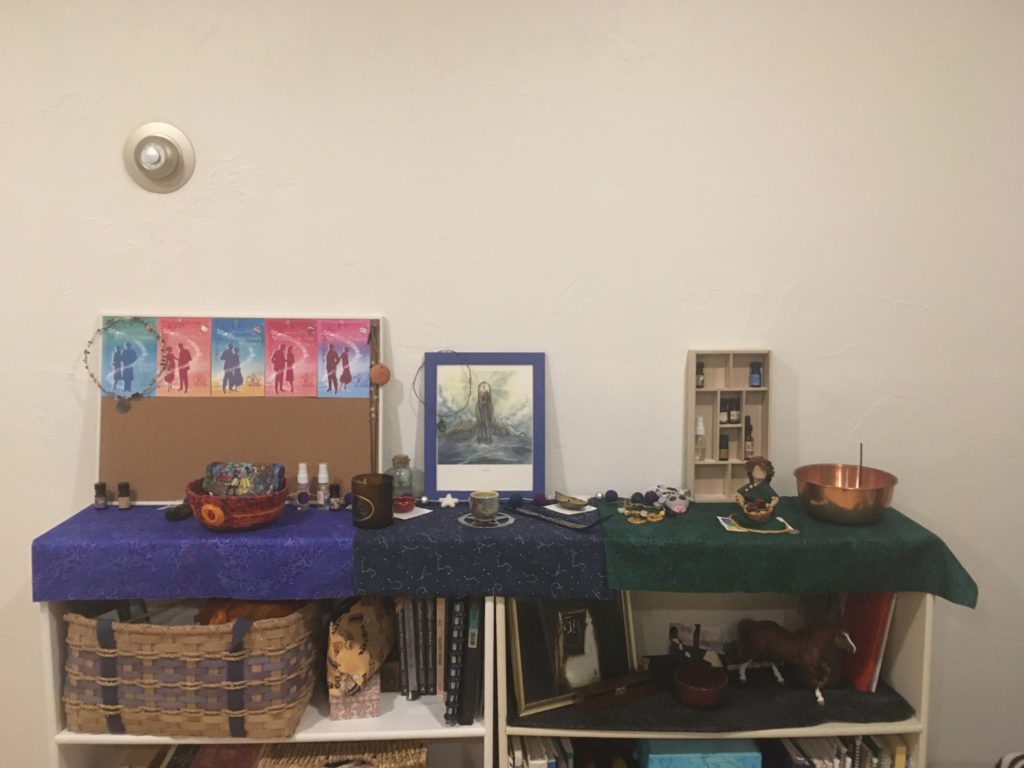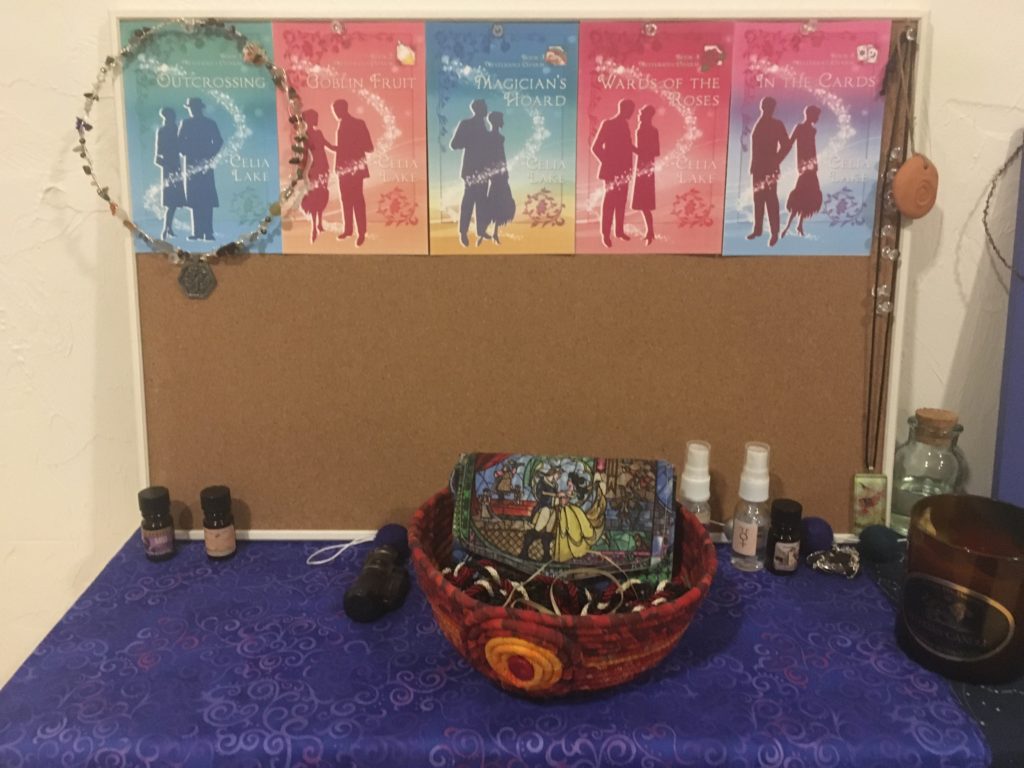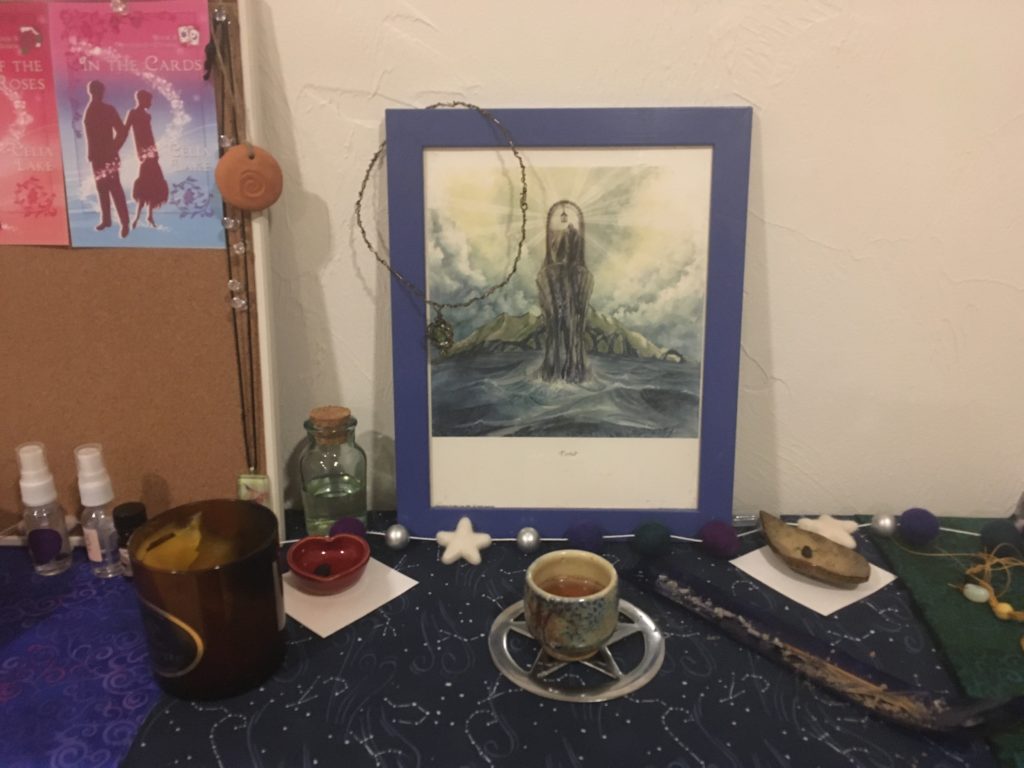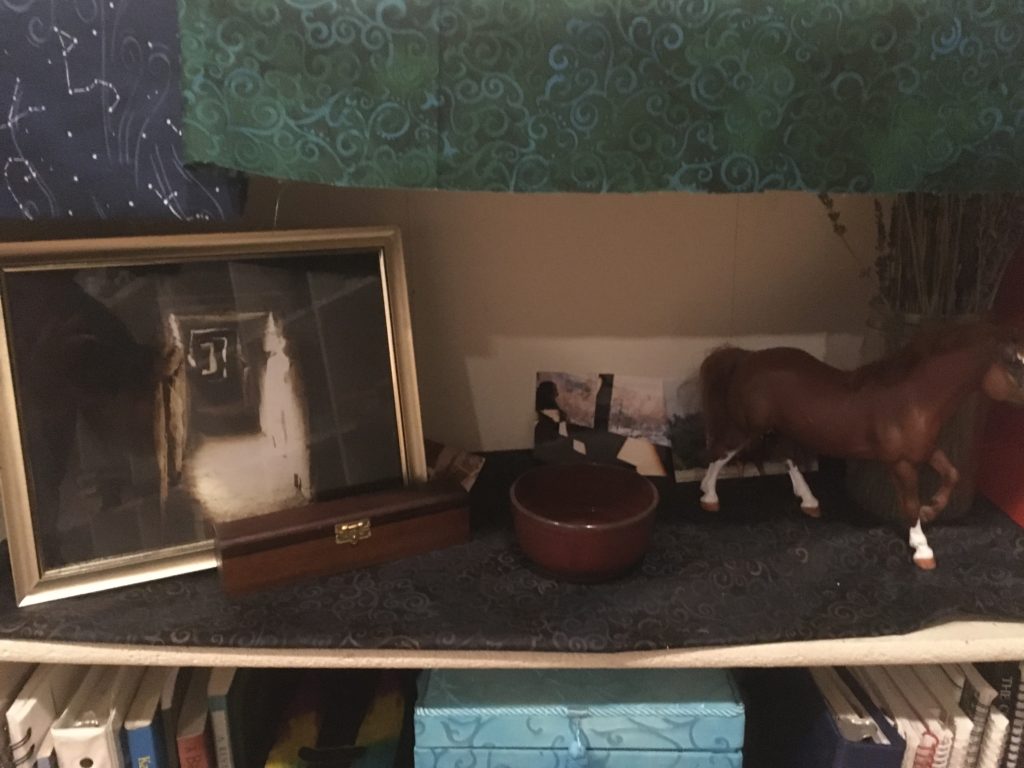One comment I’ve gotten from people is that it’d be lovely to see actual images of tools. Because items may change over time, though, I’d rather have a single place where I describe them (and can update easily), rather than have it scattered across the site. This is obviously an image heavy post, and items are described in detail in the surrounding text.
Athames and boline:
Here are two athames and a boline.
I don’t have my initial athame, which was a very simple eating dagger model (the kind you can get from many Pagan stores for under $25 or so) – most of the time, I used my first two fingers on my projecting hand, instead.
The top blade (simple leather grip) was bought at the Minnesota Renaissance Festival in 2007 from a maker called Arms and Armor. It was my ‘I finished my graduate degree’ present to myself, but while I like some parts of it very much, it’s never quite worked for me as a ritual tool as I’d like.
The middle blade is a recent commission, intended to last the rest of my life, thank you. It’s a unique piece (and a glorious piece of art) made by Omega Artworks. They also make non-custom or lightly customised (i.e. from material and fittings they have available), and I highly recommend their work and their approach to magical tools. You can read more about mine (and see more detailed images).
The bottom blade was a gift from a good friend. It was made by a blade maker from the Minnesota Renaissance Festival from quite a long time ago (she was a performer out there long before I met her) and I’m afraid I don’t know the name of the maker. When she divested herself of a lot of her Pagan tools, this came to me, and I’m delighted at how well it matches the athame in feel and workmanship. The handle is antler.
Wands:
As you can see, I like wood for wands.
- The top two I made myself or they were made as part of training. The top one is yew, and I can’t find my notes currently on what the other is.
- The next three were made on a lathe. The first and third were gifts, the second was from a shop in Salem, MA. I liked the rustic nature of it, and I’d been looking for something made of apple wood for a while.
- The last one is, yes, a conductor’s baton – I’m not sure I’d suggest it to anyone who hasn’t at least learned about conducting, but I’ve had this one since my senior year in college conducting class, and it’s been very effective as a magical wand at times.
Chalices:
Here are three chalices, with different kinds of use.
The one on the left is blue-glazed ceramic, and I love how it feels in my hand. It was handmade by someone I knew online, and we did a swap at one point when I think I was still in my Dedicant year. I’ve kept it ever since. It’s a little small for a group ritual if there’s more than a couple of people, but otherwise it’s great, and it’s very steady and unlikely to tip.
The smaller cup in the middle came from a commercial pottery shop that usually does things like mugs for tea. I really loved this little piece, which has a tree done in incised clay and glaze. It’s just big enough for a few swallows, so I often use it if I am currently doing a daily practice that involves a small amount of liquid.
The one on the right is wood, and thus very practical if I want to take altar items somewhere, since it’s hard to damage. It also has a nice feel in the hand. I find it a little prone to tipping if it’s not on a steady surface. I’ve had this since, I think, college, when I was doing Society for Creative Anachronism, but a number of Renaissance Festivals, medieval faires, re-enactment groups, and other similar events will have wooden items like this.
Pentacle:

My pentacle is probably my most boring altar tool – this came from a Pagan store, it’s plain silver metal. It is, however, nicely flat to put things on.
Altar:
From left to right, here are
- Salt dish, small dish for mixing water and salt, blue glass bottle with water.
- Statue of deity or other relevant figures (this is my Hypatia statue)
- Chalice (usually kept to the back until needed, to avoid knocking it over.)
- Deity and ancestor candles (Lady, Ancestors, Lord, left to right here)
- Pentacle with my ritual jewelry and cords on it. (The white, red, and black cords represent my 3rd degree)
- Athame
- Incense holder.
- Wand (often not on the main altar: we more commonly use them for quarter calls)
- Red candle holder for a tradition-specific practice
- Fan (for wafting incense.)
Shrine:
I moved in early 2019 to an apartment with a living room which had much better space for multiple shrines.
Venus and Jupiter
I have a shrine in my bedroom that is roughly ‘Venus and Jupiter’ or ‘beauty and expansion/abundance’. It’s in the bedroom because that’s where I spend the bulk of my waking time at home (it’s where the computer is.)

The three prints are from Wiltshire artist Hannah Willow. From left to right, they are Guardian of the Ancient Land, He Was Made of Stars, and Mother of All Herds II.

The jewellry trees and silk altar cloth are from Etsy, the candle is the Jupiter candle from Astatula Candle Co, and the jewellry itself is almost entirely from Elise Matthesen or Wyrding Studios.
Living room

This is a revised version, set up in November 2019. Before this, it was in four roughly elemental segments (air for writing, fire for connection, love, and action, water for offerings, and earth for prosperity.)
Now it’s in three segments: writing (and a bit of romance), offerings, and prosperity, with the ancestor/beloved dead shrine just below. The basket on the lower left holds many of my smaller ritual items, and the books on the right of that are published or otherwise important works.

Besides my day job, I am writing and self-publishing romance novels (1920s with magic! I have fun with them.) As each one comes out, I add the cover to the board, so I can use it as a focus for magical workings.
I got the wallet with fabric based on the Disney Beauty and the Beast stained glass from the title sequence a few years ago. It’s currently empty, but I use it as a place to stick intentions about connecting with other people (in varying forms, not just romantic.) The bowl holds things like my ritual cords and ritual jewellery. The small black thing to the left of the bowl is a lighter.
The various bottles you can see are some of the Venus-related oils and waters from Sphere and Sundry. (They’re out here rather than the bedroom because if I’m going to put on an oil, I do it when I do the morning offerings, which I do in the living room.)

The central area of the shrine space has what I use for regular offerings. At the front you can see a beeswax candle in a glass holder (from Mithras Candle), a small ceramic cup (currently holding mead), and my incense holder.
I don’t make physical offerings daily, but once a week, I light the candle, light incense, and fill the cup with something (usually mead or wine, but sometimes cream or something else), and spend time in that room for a bit.
The two small dishes (the heart and leaf) have lodestones in them, and I feed the lodestones with the liquid (gin, in this case) in the jar at the back.
The print is an early Stephanie Pui-Mun Law print called Portal. I’ve loved it since I got it well over a decade ago now.

The section on the right is for prosperity work. The statue in the middle I made from polymer clay. The little stuffed cow to the back right is from the prosperity work at Beltane I do with friends (they are flung over a bonfire as a symbolic representation for running cows between the Beltane fires in Irish tradition.)
The bracelet on the left was a gift from one of my fellow Alternity player-authors at the end of the project (she made them for everyone, based on something in the project). It’s on my shrine as a reminder of the powers of cooperation, ingenuity, and combination of having hope things will get better and actually doing things to make that happen.
The wooden shelving holds various prosperity and expansion related oils. Sometimes they’re applied to me, sometimes to the shrine figure, sometimes to something I can hang in my room.
The large copper mixing bowl is my portable hearth shrine. This summer I got some ancestral nudging of ‘you could do better on the housekeeping’, and I wanted to put together a hearth shrine I could move into different spaces as needed. Inside the bowl is an incense holder, and a small copper tea light holder (and tea light). When I’m doing more extensive housekeeping, I light them both and put the bowl in the room I’m working in. I love the way the copper reflects the light.

You can see some of my ancestor items – a model of my beloved pony, Dot, a photo of my father, a set of platonic solids in a handsome wooden case. And a ceramic bowl for water offerings.
The thing lurking in the back right is dried lavender in a jar. There are a few books you can’t see leaning against the edge of the shelf on the right.
Previous (2017 version)
My shrine, current as of January 1, 2017. On it, from left to right (roughly) here’s what we have:
- Hypatia statue (self-made), ancestor of profession.
- Small bowl with perfume for self-anointing.
- Blue glass bottle with water.
- Chalice, with a bracelet with particular personal meaning around the base.
- Tradition-specific candle, with a harpstring coiled around the base.
- Watercolor and ink abstract illustration for reasons that please me and make me think (by a local artist I met last summer. It’s on there for about 5 reasons, and only one is about the actual art you can see.)
- In front, my athame.
Decorative items:
A larger image of the decorative items – a variety I’ve kept through the years. They include:
- Antlers (gift from a friend)
- My Hypatia statue (closer shot below)
- Horse chestnuts, which are one of the signs of fall to me, and also (unlike a lot of natural plant objects) keep for a very long time.
- A fabric dancing figure.
- A piece of carnelian
- A cobalt glass bottle
- A lapis bear with a fish in its mouth.
Here’s a better shot of Hypatia – as you can see in the closeup, her thumb has broken off over time, and I should make a new one. You can see I didn’t try to do detailing outside of my abilities – no face, no eyes, and she’s sitting crosslegged to provide a solid base and avoid my having to do anything with feet or legs. I’ve found I rather like the effect, though. I’ve done similar figures for long-term prosperity workings, too.










